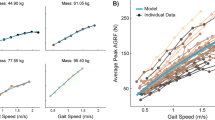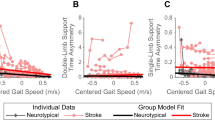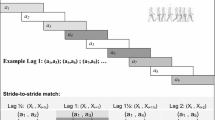Abstract
A number of variability analysis techniques, including Poincaré plots and detrended fluctuation analysis (DFA) were used to investigate minimum toe clearance (MTC) control during walking. Ten young adults walked on a treadmill for 10 min at preferred speed in three conditions: (i) no-intervention baseline, (ii) with biofeedback of MTC within a target range, and (iii) no-biofeedback retention. Mean, median, standard deviation (SD), and inter quartile range of MTC during biofeedback (45.57 ± 11.65, 44.98 ± 11.57, 7.08 ± 2.61, 8.58 ± 2.77 mm, respectively) and retention (56.95 ± 20.31, 56.69 ± 20.94, 10.68 ± 5.41, 15.38 ± 10.19 mm) were significantly greater than baseline (30.77 ± 9.49, 30.51 ± 9.49, 3.04 ± 0.77, 3.66 ± 0.91 mm). Relative to baseline, skewness was reduced in biofeedback and retention but only significantly for retention (0.88 ± 0.51, 0.63 ± 0.55, and 0.40 ± 0.40, respectively). Baseline Poincaré measures (SD1 = 0.25, SD2 = 0.34) and DFA (α1 = 0.72 and α2 = 0.64) were lower than biofeedback (SD1 = 0.58, SD2 = 0.83, DFA α1 = 0.76 and α2 = 0.92) with significantly greater variability in retention compared to biofeedback only in the long-term SD2 and α2 analyses. Increased DFA longer-term correlations α2 in retention confirm that a novel gait pattern was acquired with a longer-term variability structure. Short- and long-term variability analyses were both useful in quantifying gait adaptations with biofeedback. The findings provide evidence that MTC can be modified with feedback, suggesting future applications in gait training procedures for impaired populations designed to reduce tripping risk.


Similar content being viewed by others
References
Barrett, R. S., P. M. Mills, and R. K. Begg. A systematic review of the effect of ageing and falls history on minimum foot clearance characteristics during level walking. Gait Posture 32:429–435, 2010.
Basmajian, J. V. Biofeedback in rehabilitation: a review of principles and practices. Arch. Phys. Med. Rehabil. 62:469–475, 1981.
Batavia, M., J. G. Gianutsos, and M. Kambouris. An augmented auditory feedback device. Arch. Phys. Med. Rehabil. 78:1389–1392, 1997.
Batavia, M., J. G. Gianutsos, A. Vaccaro, and J. T. Gold. A do-it-yourself membrane-activated auditory feedback device for weight bearing and gait training: a case report. Arch. Phys. Med. Rehabil. 82:541–545, 2001.
Begg, R., R. Best, L. Dell’Oro, and S. Taylor. Minimum foot clearance during walking: strategies for the minimisation of trip-related falls. Gait Posture 25:191–198, 2007.
Begg, R. K., M. Palaniswami, and B. Owen. Support vector machines for automated gait classification. IEEE Trans. Biomed. Eng. 52:828–838, 2005.
Brennan, M., M. Palaniswami, and P. Kamen. Do existing measures of Poincare plot geometry reflect nonlinear features of heart rate variability? IEEE Trans. Biomed. Eng. 48:1342–1347, 2001.
Carrasco, S., M. J. Gaitan, R. Gonzalez, and O. Yanez. Correlation among Poincare plot indexes and time and frequency domain measures of heart rate variability. J. Med. Eng. Technol. 25:240–248, 2001.
Dingwell, J. B., and J. P. Cusumano. Re-interpreting detrended fluctuation analyses of stride-to-stride variability in human walking. Gait Posture 32:348–353, 2010.
Femery, V. G., P. G. Moretto, J. M. Hespel, A. Thevenon, and G. Lensel. A real-time plantar pressure feedback device for foot unloading. Arch. Phys. Med. Rehabil. 85:1724–1728, 2004.
Hausdorff, J. M., S. L. Mitchell, R. Firtion, C. K. Peng, M. E. Cudkowicz, J. Y. Wei, and A. L. Goldberger. Altered fractal dynamics of gait: reduced stride-interval correlations with aging and Huntington’s disease. J. Appl. Physiol. 82:262–269, 1997.
Hausdorff, J. M., C. K. Peng, Z. Ladin, J. Y. Wei, and A. L. Goldberger. Is walking a random walk? Evidence for long-range correlations in stride interval of human gait. J. Appl. Physiol. 78:349–358, 1995.
Hausdorff, J. M., P. L. Purdon, C. K. Peng, Z. Ladin, J. Y. Wei, and A. L. Goldberger. Fractal dynamics of human gait: stability of long-range correlations in stride interval fluctuations. J. Appl. Physiol. 80:1448–1457, 1996.
Hausdorff, J. M., L. Zemany, C. Peng, and A. L. Goldberger. Maturation of gait dynamics: stride-to-stride variability and its temporal organization in children. J. Appl. Physiol. 86:1040–1047, 1999.
Hirokawa, S., and K. Matsumura. Biofeedback gait training system for temporal and distance factors. Med. Biol. Eng. Comput. 27:8–13, 1989.
Kamen, P. W., and A. M. Tonkin. Application of the Poincare plot to heart rate variability: a new measure of functional status in heart failure. Aust. N. Z. J. Med. 25:18–26, 1995.
Kassover, M., C. Tauber, J. Au, and J. Pugh. Auditory biofeedback in spastic diplegia. J. Orthop. Res. 4:246–249, 1986.
Khandoker, A. H., M. Palaniswami, and R. K. Begg. A comparative study on approximate entropy measure and Poincare plot indexes of minimum foot clearance variability in the elderly during walking. J. Neuroeng. Rehabil. 5:4, 2008.
Khandoker, A. H., S. B. Taylor, C. K. Karmakar, R. K. Begg, and M. Palaniswami. Investigating scale invariant dynamics in minimum toe clearance variability of the young and elderly during treadmill walking. IEEE Trans. Neural Syst. Rehabil. Eng. 16:380–389, 2008.
Lai, D. T., R. K. Begg, S. Taylor, and M. Palaniswami. Detection of tripping gait patterns in the elderly using autoregressive features and support vector machines. J. Biomech. 41:1762–1772, 2008.
Mills, P. M., R. S. Barrett, and S. Morrison. Toe clearance variability during walking in young and elderly men. Gait Posture 28:101–107, 2008.
Montoya, R., P. Dupui, B. Pages, and P. Bessou. Step-length biofeedback device for walk rehabilitation. Med. Biol. Eng. Comput. 32:416–420, 1994.
Peng, C. K., S. Havlin, H. E. Stanley, and A. L. Goldberger. Quantification of scaling exponents and crossover phenomena in nonstationary heartbeat time series. Chaos 5:82–87, 1995.
Penzel, T., J. W. Kantelhardt, L. Grote, J. H. Peter, and A. Bunde. Comparison of detrended fluctuation analysis and spectral analysis for heart rate variability in sleep and sleep apnea. IEEE Trans. Biomed. Eng. 50:1143–1151, 2003.
Salmoni, A. W., R. A. Schmidt, and C. B. Walter. Knowledge of results and motor learning: a review and critical reappraisal. Psychol. Bull. 95:355–386, 1984.
Seeger, B. R., D. J. Caudrey, and J. R. Scholes. Biofeedback therapy to achieve symmetrical gait in hemiplegic cerebral palsied children. Arch. Phys. Med. Rehabil. 62:364–368, 1981.
Sparrow, W. A. Acquisition and retention effects of reduced relative frequency of knowledge of results. Aust. J. Psychol. 42:97–104, 1995.
Sparrow, W. A., R. K. Begg, and S. Parker. Variability in the foot–ground clearance and step timing of young and older men during single-task and dual-task treadmill walking. Gait Posture 28:563–567, 2008.
Sparrow, W. A., and J. J. Summers. Performance on trials without knowledge results (KR) in reduced relative frequency presentations of KR. J. Mot. Behav. 24:197–209, 1992.
Stergiou, N., R. Harbourne, and J. Cavanaugh. Optimal movement variability: a new theoretical perspective for neurologic physical therapy. J. Neurol. Phys. Ther. 30:120–129, 2006.
Walker, S. C., P. A. Helm, and L. A. Lavery. Gait pattern alteration by functional sensory substitution in healthy subjects and in diabetic subjects with peripheral neuropathy. Arch. Phys. Med. Rehabil. 78:853–856, 1997.
Zeni, Jr., J. A., J. G. Richards, and J. S. Higginson. Two simple methods for determining gait events during treadmill and overground walking using kinematic data. Gait Posture 27:710–714, 2008.
Acknowledgments
The work was supported in part by Victoria University internal grant (ARC near-miss grant) and Australian Government Collaborative Research Networks (CRN) program.
Author information
Authors and Affiliations
Corresponding author
Additional information
Associate Editor Thurmon E. Lockhart oversaw the review of this article.
Rights and permissions
About this article
Cite this article
Tirosh, O., Cambell, A., Begg, R.K. et al. Biofeedback Training Effects on Minimum Toe Clearance Variability During Treadmill Walking. Ann Biomed Eng 41, 1661–1669 (2013). https://doi.org/10.1007/s10439-012-0673-6
Received:
Accepted:
Published:
Issue Date:
DOI: https://doi.org/10.1007/s10439-012-0673-6




